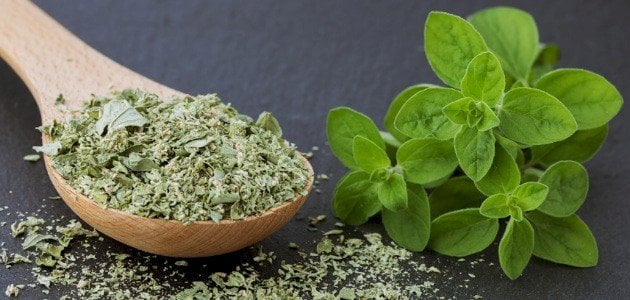Classification of marjoram herb
Marjoram herb (in English: Marjoram) and its scientific name is (Origanum majorana), and it is also known as sweet marjoram.[XNUMX] or oregano,[XNUMX]They are perennial plants that are classified into the mint family (in English: Lamiaceae), called the Lamiaceae family. It is noted that they have an aromatic and slightly sharp flavor, which is why they are used in some food recipes.[XNUMX]
General description of marjoram herb
The marjoram herb is characterized by characteristics that distinguish it from other herbs, which are as follows:
- Shape and color of marjoram herb
The marjoram herb is characterized by its oval leaves and long stem.[XNUMX] Its leaves are green in color, and together they form a group of distinctive knots called knotted marjoram.[XNUMX]
- Marjoram flavour
The taste of marjoram is characterized by being mixed with more than one flavour. It has a sour taste and a flavor similar to thyme, but it is sweeter and has a stronger smell. It also has a sharp and slightly bitter flavour.[XNUMX] The flavor of marjoram is more pronounced if it is not overcooked.[XNUMX]
- Size and length of the marjoram herb
Marjoram can grow to a height of between 60-90 cm.[XNUMX]
Read also:Where is saffron extracted from?Places of spread of marjoram herb
The marjoram herb lives and thrives in warm, sunny weather. It is worth noting that it can be grown and flourish in areas where the temperature is not less than 10 degrees Celsius, such as the northern United States, but when it is exposed to very cold weather, it can lose its distinctive flavor.[XNUMX]
The cultivation of marjoram is widespread in California, Mexico, and Latin America, and it is usually exported from some countries to other countries.[XNUMX] It is worth noting that it grew primarily in the Mediterranean, North Africa, and West Asia.[XNUMX]
Cultivation of marjoram herb
Many people prefer to grow marjoram in the garden or on the kitchen window; This is to enjoy its good taste, in addition to being an herb that attracts butterflies and insects in the home garden.[XNUMX] To grow marjoram, you must follow the following:
- Marjoram seeds should be planted indoors in cold climates. That is, from February to May, by planting 3 seeds in the pot. It is also preferable to plant them in small pots and water them with a warm water spray.[XNUMX]
- Soak the seeds in water overnight; To accelerate its growth before planting it.[XNUMX]
- Seedlings are transferred to larger pots when they become larger.[XNUMX] Multi-purpose fertilizer is also added to it.[XNUMX]
- Transplant them outdoors as soon as the weather warms and the danger of frost passes.[XNUMX]
- The marjoram herb must be watered after it is transferred to the soil, but it must be watered in the pots regularly, taking care not to overdo it.[XNUMX]
- The herb must be cared for after planting by pruning it after the flowers have disappeared and cutting off any dead stems at its base.[XNUMX]
- It is preferable to place the pot of marjoram herb in a well-lit place under a cover.[XNUMX]
- People can pick marjoram at any time of the year, but the best time is summer; Because its flavor is stronger, in addition to making sure to choose marjoram leaves before the flower buds open, so that the leaves can be used fresh or after drying.[XNUMX]
How to care for marjoram after planting
Marjoram, like any other plant, needs care after planting it. To take good care of it, you must follow the following tips:[XNUMX]
Read also:Moringa plant- Marjoram seedlings should be kept watered regularly.
- Marjoram leaves should be pruned throughout its growing season.
- Cut the marjoram leaves and branches; To become close to the ground, and that is when the flowers begin to appear; To stimulate its growth again.
- Marjoram is left planted in the ground in the southern regions, but in the northern regions it is placed in pots at the end of the season and moved to well-sunned windows.
- Young marjoram leaves should be harvested throughout its growing season; Use fresh, freeze for later use, or dry and store in an airtight container in a dark, dry area.
Benefits of marjoram herb and its most prominent uses
The marjoram herb has many benefits from a scientific standpoint, the most notable of which are:[XNUMX]
- Antioxidants and anti-inflammatory
Experiments have shown that marjoram has many compounds that have antioxidant effects, such as carvacrol, as these antioxidants help reduce inflammation in the human body.
- Antimicrobial activity
Marjoram has many antimicrobial properties, such as treating fungal microbes found on the skin, or treating intestinal bacterial overgrowth.
- Alleviating digestive problems
Scientific studies have proven that marjoram treats digestive system problems, such as stomach ulcers and some foodborne diseases.
Read also:Goro fruit- Regulating the menstrual cycle and hormones
According to scientific studies, this plant stimulates menstrual flow, helps restore hormonal balance in non-pregnant women who suffer from irregular cycles, and also helps in treating polycystic ovary syndrome (PCOS).
Despite its many advantages, it has some Damage Which you should be careful of, the most notable of which are the following:[XNUMX]
- Effect on pregnant and breastfeeding women
This is due to its effect on reproductive hormones in pregnant or breastfeeding women, as this herb leads to negative side effects during pregnancy.
- Effect on blood clotting
One study that analyzed 20 types of marjoram found that it may inhibit the formation of platelets, an essential factor in blood clotting.
- Interaction with some medications
Studies have shown that taking marjoram with medications may have side effects, such as the herb interacting with blood thinners and anticoagulants, which may lead to an increased risk of bleeding. It may also interact with some diabetes medications by lowering blood sugar, leading to Its levels are dangerously low.









